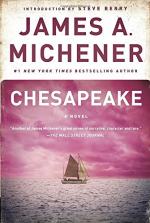|
This section contains 807 words (approx. 3 pages at 400 words per page) |

|
Chesapeake: A Novel Summary & Study Guide Description
Chesapeake: A Novel Summary & Study Guide includes comprehensive information and analysis to help you understand the book. This study guide contains the following sections:
This detailed literature summary also contains Quotes and a Free Quiz on Chesapeake: A Novel by James A. Michener.
The following version of the novel was used to create this study guide: Michener, James A. Chesapeake. The Dial Press, December 17, 2013. Kindle.
In the novel Chesapeake by James A. Michener, Michener traces the lives of several founding families of the Chesapeake area beginning with the Native Americans in 1583 through the impact of the Watergate Scandal in the 1970s. Central to the novel is Devon Island, a physically beautiful island rejected by Pentaquod, an Indian who fled to the area in search of peace because he noticed erosion. English settler Edmund Steed, who fled religious prosecution, settled his family on the island. As Pentaquod noticed, the island slowly eroded until a terrible hurricane in 1978 washed it away completely, demonstrating humans will never have control over the land.
The novel is divided into 14 major periods of history. Each of these periods is introduced with the story of a voyage. For instance, 1583 begins with Pentaquod’s voyage from his Susquehannock village to the Chesapeake Bay Area seeking peace. Other voyages described include Edmund Steed’s voyage from England seeking freedom from religious persecution and the voyage made by Cudjo, a slave from Africa who mutinies the slave ship in hopes of freeing himself and the other captives. The migration of geese from Canada to the Chesapeake is another voyage that is described. Another example of the voyages described is the track of a hurricane that desalinates the bay area, threatening the oyster and crab trade.
Pentaquod, a Susquehannock Indian, escaped his warring tribe and settled with a tribe of Choptank Indians on the eastern side of the Chesapeake Bay. He considered living alone on a beautiful island, but decided against it when he noticed the rate at which the waves were eroding the banks. Pentaquod befriended the Americans who first settled in the Chesapeake area, but cut ties with them when they began burning acres of woodland to plant tobacco to send back to England.
Edmund Steed was among the first settlers from England in the Chesapeake area. He was a devoted Catholic who wanted the freedom to practice his religion. He did not notice the erosion of the island and bought that property from the Indians by barter. His family became known for the property and plantations they owned. They stood in favor of slavery and fought against it being outlawed.
Timothy Turlock, a thief from England, was saved from death by hanging by being sold as an indentured servant. He was the first in the line of Turlocks, a cunning group of people who hunted, fished, and outsmarted the officials. One member of the Turlock family became a real estate agent and turned the family’s marshland into million-dollar lots.
Edward Paxmore, a Quaker, who was beaten for his religious beliefs was the father of the Paxmore family. This family was known for its religious fervor as well as its stance against slavery. The Paxmores protected abused slaves and helped them escape to freedom in the north even though it was against the law. The Paxmore family was also known for its skills building boats. Eventually, these skills were also put to use in building airplanes.
Cudjo and Eden Cater, the first slaves to be granted their freedom in the Chesapeake area, were the progenitors of a line of Blacks in this area. They were hardworking and resourceful. The story of their family is used to illustrate how difficult life was even for free Blacks during and following the time slavery was abolished. Eden helped lead Blacks to freedom. Later generations began the fight for equal rights and treatment for Blacks.
In the later years of the story, Pusey Paxmore, Owen Steed, and Hiram Cater, were all three men born in the Chesapeake area who left their hometown with ideas of greatness. Pusey was jailed as a result of his complicity with the Watergate scandal. Owen was forced to retire because he provided funds to Pusey even though Pusey never mentioned Owen’s contribution. Hiram was the first Black man in the Chesapeake area accepted by the Marines, but his travel during the service confirmed for him how badly Blacks were treated in America. Later at home, Hiram’s comments set off a fiery riot that destroys not only the Black section of town, but also the Paxmore’s boatyard.
In the final section, after Pusey died by suicide as the result of his guilt, the Paxmores, Caters, and Turlocks paid their respects by traveling to Pusey’s burial by boat even though there was a hurricane coming. The following morning, the Paxmores and others surveyed the damage from Peace Cliff, where they had taken refuge, to discover the remnants of Devon Island, the island rejected by Pentaquod but the place where the Steed family had built a great plantation and house, were gone.
Read more from the Study Guide
|
This section contains 807 words (approx. 3 pages at 400 words per page) |

|



